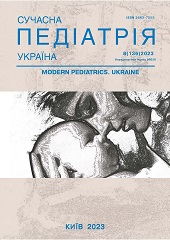Prematurely closed arterial duct: possible risks for the newborn
DOI:
https://doi.org/10.15574/SP.2023.136.124Keywords:
patent ductus arteriosus, right ventricular hypertrophy, pulmonary hypertension, newbornAbstract
Premature closure of the fetal ductus arteriosus is a rare phenomenon that results in increased right ventricular pressure, leading to the development of isolated right ventricular hypertrophy, high pulmonary hypertension, and even death.
Purpose - to present a rare clinical case of prenatally closed ductus arteriosus in a newborn boy, that clinically manifested by severe respiratory failure immediately after birth.
Clinical case. The child was admitted to the neonatal intensive care unit 5 hours after delivery with clinical signs of severe respiratory failure, child was oxygen-dependent.
It is known from the anamnesis that the child was delivered by urgent cesarean section on the basis of a prenatally diagnosed prematurely closed arterial duct. A week before the delivery, the mother had an acute respiratory viral infection accompanied by high fever, which was treated with high doses of over-the-counter ibuprofen.
The 2D echocardiography showed severe hypertrophy of the right ventricular wall and tricuspid insufficiency, which was caused by premature closure of the ductus arteriosus. The flow through the ductus arteriosus was not determined. Aortic coarctation as a possible cause of right ventricular hypertrophy in the newborn period was excluded.
The infant was switched to constant positive pressure artificial ventilation (CPAP) to reduce pulmonary vascular resistance and afterload of the right ventricle.
Over the next 3-4 weeks of oxygen therapy, the child's general condition improved significantly. Hypertrophy of the right ventricular wall regressed to normal size, the child grows and develops according to age.
Conclusions. Premature prenatal closure of the arterial duct can be idiopathic or caused drugs intake that suppress prostaglandin production late in the pregnancy. Pregnant women should be counseled about the potential side effects on the fetus caused by the use of NSAIDs, especially in the third trimester of pregnancy.
Urgent delivery and oxygen therapy contribute to the regression of intracardiac changes and significantly improve general condition of the child.
The study was conducted in accordance with the principles of the Declaration of Helsinki. The informed consent of the child’s parents was obtained for the study.
No conflict of interests was declared by the authors.
References
Battistoni G, Montironi R, Di Giuseppe J, Giannella L, Carpini GD, Baldinelli A et al. (2021). Foetal ductus arteriosus constriction unrelated to non-steroidal anti-Inflammatory drugs: a case report and literature review. Annals of Medicine. 53 (1): 860-873. https://doi.org/10.1080/07853890.2021.1921253; PMid:34096417 PMCid:PMC8189142
Choi EY, Li M, Choi CW, Park KH, Choi JY. (2013). A case of progressive ductal constriction in a fetus. Korean Circ J. 43(11): 774-781. https://doi.org/10.4070/kcj.2013.43.11.774; PMid:24363755 PMCid:PMC3866319
Chugh BD, Makam A. (2020). Diagnosis and management of fetal ductus arteriosus constriction. J Fetal Med. 7(3): 235-242. https://doi.org/10.1007/s40556-020-00266-3
Ishida H, Inamura N, Kawazu Y et al. (2011). Clinical features of the complete closure of the ductus arteriosus prenatally. Congenit Heart Dis. 6: 51-56. https://doi.org/10.1111/j.1747-0803.2010.00411.x; PMid:21269413
Ishida H, Kawazu Y, Kayatani F, Inamura N. (2016). Prognostic factors of premature closure of the ductus arteriosus in utero: a systematic literature review. Cardiol Young. 27(4): 634-638. https://doi.org/10.1017/S1047951116000871; PMid:27322829
Lopes LM, Carrilho MC, Francisco RP et al. (2016). Fetal ductus arteriosus constriction and closure: analysis of the causes and perinatal outcome related to 45 consecutive cases. J Matern Fetal Neonatal Med. 29: 638-645. https://doi.org/10.3109/14767058.2015.1015413; PMid:25708490
Nagasawa H, Hamada C, Wakabayashi M, Nakagawa Y, Nomura S, Kohno Y. (2016). Time to spontaneous ductus arteriosus closure in full-term neonates. Open Heart. 3(1): e000413. https://doi.org/10.1136/openhrt-2016-000413; PMid:27239325 PMCid:PMC4874051
Pedra SRFF, Zielinsky P, Binotto CN et al. (2019, Jun 6). Brazilian Fetal Cardiology Guidelines - 2019. Arq Bras Cardiol. 112(5): 600-648. https://doi.org/10.5935/abc.20190075; PMid:31188968 PMCid:PMC6555576
Rakha S. (2017). Excessive maternal orange intake - a reversible etiology of fetal premature ductus arteriosus constriction: a case report. Fetal Diagn Ther. 42(2): 158-160. https://doi.org/10.1159/000453063; PMid:28746929
Shima Y, Ishikawa H, Matsumura Y, Yashiro K, Nakajima M, Migita M. (2010). Idiopathic severe constriction of the fetal ductus arteriosus: a possible underestimated pathophysiology. Eur J Pediatr. 170(2): 237-240. https://doi.org/10.1007/s00431-010-1295-3; PMid:20845046
Sridharan S, Archer N, Manning N. (2009). Premature constriction of the fetal ductus arteriosus following the maternal consumption of chamomile herbal tea. Ultrasound Obstet Gynecol. 34: 358-359. https://doi.org/10.1002/uog.6453; PMid:19705407
Downloads
Published
Issue
Section
License
Copyright (c) 2023 Modern pediatrics. Ukraine

This work is licensed under a Creative Commons Attribution-NonCommercial 4.0 International License.
The policy of the Journal “MODERN PEDIATRICS. UKRAINE” is compatible with the vast majority of funders' of open access and self-archiving policies. The journal provides immediate open access route being convinced that everyone – not only scientists - can benefit from research results, and publishes articles exclusively under open access distribution, with a Creative Commons Attribution-Noncommercial 4.0 international license (СС BY-NC).
Authors transfer the copyright to the Journal “MODERN PEDIATRICS. UKRAINE” when the manuscript is accepted for publication. Authors declare that this manuscript has not been published nor is under simultaneous consideration for publication elsewhere. After publication, the articles become freely available on-line to the public.
Readers have the right to use, distribute, and reproduce articles in any medium, provided the articles and the journal are properly cited.
The use of published materials for commercial purposes is strongly prohibited.

